#Cerro Armazones
Explore tagged Tumblr posts
Text

Construction of the Observatory for the European Extremely Large Telescope in Atacama Desert, Chile.
Credits: https://www.eso.org/public/chile/images/potw2336a/
#ESO#Telescope#Observatory#Astronomy#Sun#Chile#Cerro Armazones#Armazones#Paranal#Observatorio#Astronomical Observatory#Observatorio Astronómico#Astronomía#Ciencia#Science#Technology#Tecnología#Sol#Atardecer#Sunset#Extremely Large Telescope
164 notes
·
View notes
Photo
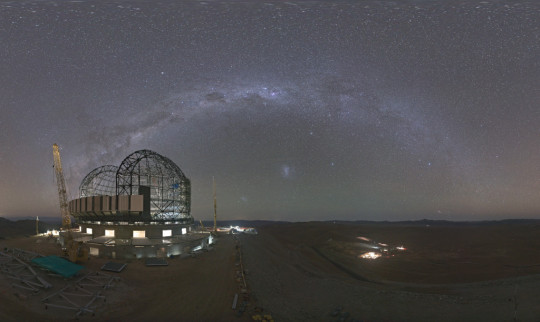
2024 March 16
ELT and the Milky Way Image Credit & License: European Southern Observatory - Courtesy: Jens Scheidtmann
Explanation: The southern winter Milky Way sprawls across this night skyscape. Looking due south, the webcam view was recorded near local midnight on March 11 in dry, dark skies over the central Chilean Atacama desert. Seen below the graceful arc of diffuse starlight are satellite galaxies of the mighty Milky Way, also known as the Large and Small Magellanic clouds. In the foreground is the site of the European Southern Observatory's 40-metre-class Extremely Large Telescope (ELT). Under construction at the 3000 metre summit of Cerro Armazones, the ELT is on track to become planet Earth's biggest Eye on the Sky.
∞ Source: apod.nasa.gov/apod/ap240316.html
105 notes
·
View notes
Text
2024 March 16
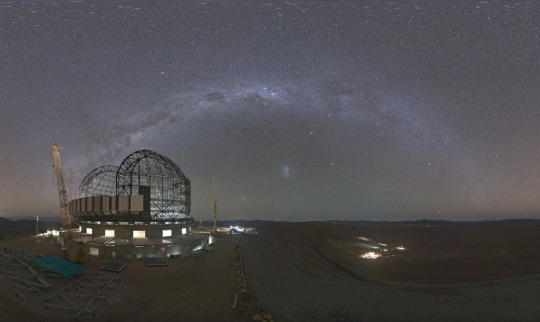
ELT and the Milky Way
Image Credit & License: European Southern Observatory - Courtesy: Jens Scheidtmann
Explanation: The southern winter Milky Way sprawls across this night skyscape. Looking due south, the webcam view was recorded near local midnight on March 11 in dry, dark skies over the central Chilean Atacama desert. Seen below the graceful arc of diffuse starlight are satellite galaxies of the mighty Milky Way, also known as the Large and Small Magellanic clouds. In the foreground is the site of the European Southern Observatory's 40-metre-class Extremely Large Telescope (ELT). Under construction at the 3000 metre summit of Cerro Armazones, the ELT is on track to become planet Earth's biggest Eye on the Sky.
#astronaut#astronomers#not astrology#star#stars#art#astronomy#outer space#space#artist#milky way#constellation#constellations#telescope#telescopes#extremely large telescope#ELT#large magellanic cloud#magellanic cloud
5 notes
·
View notes
Text
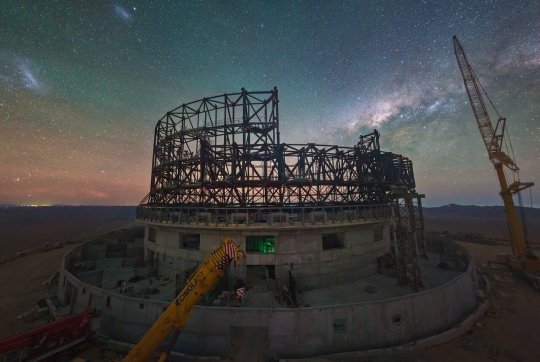

ESO’s Extremely Large Telescope is now half completed
The European Southern Observatory’s Extremely Large Telescope (ESO’s ELT) is a revolutionary ground-based telescope that will have a 39-metre main mirror and will be the largest telescope in the world for visible and infrared light: the world’s biggest eye on the sky. Construction of this technically complex project is advancing at a good pace, with the ELT now surpassing the 50% complete milestone.
The telescope is located atop Cerro Armazones in Chile's Atacama Desert, where engineers and construction workers are currently assembling the structure of the telescope dome at a staggering pace. Visibly changing each day, the steel structure will soon acquire the familiar round shape typical of telescope domes.
The telescope mirrors and other components are being built by companies in Europe, where work is also progressing well. ESO’s ELT will have a pioneering five-mirror optical design, which includes a giant main mirror (M1) made up of 798 hexagonal segments. More than 70% of the blanks and supports for these segments have now been manufactured, while M2 and M3 are cast and in the process of being polished. Progress on M4, an adaptive, flexible mirror that will adjust its shape a thousand times a second to correct for distortions caused by air turbulence, is particularly impressive: all six of its thin petals are fully finalised and being integrated into their structural unit. Further, all six laser sources, another key component of the ELT’s adaptive optics system, have been produced and delivered to ESO for testing.
All other systems needed to complete the ELT, including the control system and the equipment needed to assemble and commission the telescope, are also progressing well in their development or production. Moreover, all four of the first scientific instruments the ELT will be equipped with are in their final design phase with some about to start manufacturing. In addition, most of the support infrastructure for the ELT is now in place at or near Cerro Armazones. For example, the technical building that, among other things, will be used for storage and coating of different ELT mirrors is fully erected and fitted out, while a photovoltaic plant that supplies renewable energy to the ELT site started operating last year.
Construction of ESO’s ELT was kickstarted nine years ago with a groundbreaking ceremony. The top of Cerro Armazones was flattened in 2014 to allow for space for the giant telescope.
Continue reading/pictures/videos: https://elt.eso.org/public/news/eso2310/
#eso #large telescope #chile #telescope
18 notes
·
View notes
Text
El mayor telescopio óptico del mundo sigue creciendo
El mayor telescopio óptico del mundo, llamado el ELT (Telescopio extremadamente grande) está siendo construido en Chile. Tendrá un espejo principal de 39 metros y será el mayor telescopio óptico / infrarrojo cercano de la historia. El ELT está siendo construido en el Cerro Armazones a una altitud 3.000 metros y a 20 kilómetros del Observatorio Paranal de ESO (European Southern Observatory), que���

View On WordPress
0 notes
Video
Road to the ELT by European Southern Observatory Via Flickr: Today’s Picture of the Week captures the expansive hilltop of Cerro Armazones in Chile, the home of ESO’s Extremely Large Telescope (ELT). The Martian-esque ground may look flat from up here, but the peak is more than 3000 metres above sea level. Ground-based telescopes work best when the atmosphere between them and the Universe is kept to a minimum, making the ELT’s mountaintop perch perfect for observations. Much like the physical road up the mountain, the metaphorical road to the ELT has been equally long. Indeed, the first detailed studies for the project were given the go-ahead on this day exactly 17 years ago. This study kicked off the design process, although it wasn’t for another four years that Cerro Armazones was selected as the future home for the giant telescope. Many milestones have been surpassed since 11 December 2006, and of course, the design has changed somewhat since the original concept. Most recently, the project passed the 50% completion point, and the telescope is now expected to begin operation later this decade. Today, we’re nearing the summit of this mountain of a project. Credit: ESO/G. Vecchia
1 note
·
View note
Text

Joaquiin Murilo Murillo - QAN-Y [lpe007]
Manualmente el ser humano va dejando atrás los valores y cualquier símbolo que signifique progreso; sin embargo, a veces el útero y el feto como armazones ajenos tienen la sustancia de impulsar al individuo humano fuera de casa, que es otro lugar de hallarlo todo. Las mascotas son las propias estrellas en un mundo donde se puede encontrar el desamparo. El oro para sobrevivir está de cabeza y con ello tampoco se puede regresar al vientre materno. Las montañas, los cerros, los volcanes, el monte Fuji, el sur del Perú, las mesetas, el promontorio donde pelear de a dos para decidir si la vagina es el ano y el ano, la vagina. Las estrellas se sostienen por brasieres de costosa confección, marcas de diamantes, y colores psicodélicos. Un obrero apestado por la sociedad al laborar no sabe si ponerse a pensar en El Messiah de Händel, en una vaca con culo de hombre o en una cumbia de las que son súper creisis. Joaquiin Murillo Murillo construye un mundo personal donde el trabajo del corazón como carne y como dibujo se multiplica intensamente dejando atrás los millones de ojos con la que podamos observar cada célula de este libro.
Primera edición, junio de 2020
Número de páginas: 144
Dimensiones: 20.7 x 14.7 cm.
Accede a su lectura aquí.
0 notes
Text

The European Southern Observatory (ESO) enables scientists worldwide to discover the secrets of the Universe for the benefit of all. We design, build and operate world-class observatories on the ground — which astronomers use to tackle exciting questions and spread the fascination of astronomy — and promote international collaboration for astronomy. Established as an intergovernmental organisation in 1962, today ESO is supported by 16 Member States (Austria, Belgium, the Czech Republic, Denmark, France, Finland, Germany, Ireland, Italy, the Netherlands, Poland, Portugal, Spain, Sweden, Switzerland and the United Kingdom), along with the host state of Chile and with Australia as a Strategic Partner. ESO’s headquarters and its visitor centre and planetarium, the ESO Supernova, are located close to Munich in Germany, while the Chilean Atacama Desert, a marvellous place with unique conditions to observe the sky, hosts our telescopes. ESO operates three observing sites: La Silla, Paranal and Chajnantor. At Paranal, ESO operates the Very Large Telescope and its Very Large Telescope Interferometer, as well as survey telescopes such as VISTA. Also at Paranal ESO will host and operate the Cherenkov Telescope Array South, the world’s largest and most sensitive gamma-ray observatory. Together with international partners, ESO operates ALMA on Chajnantor, a facility that observes the skies in the millimetre and submillimetre range. At Cerro Armazones, near Paranal, we are building “the world’s biggest eye on the sky” — ESO’s Extremely Large Telescope. From our offices in Santiago, Chile we support our operations in the country and engage with Chilean partners and society.
0 notes
Text
Scientist anticipates finding life beyond our solar system in 25 years
An artist’s rendering of the Extremely Large Telescope (ELT) is currently under construction at Cerro Armazones in Chile’s Atacama Desert. It has an instrument that could help find life beyond our solar system. Credit: ESO Several missions that could detect life beyond our solar system are currently in development, Swiss astrophysicist Sasha Quanz said at the recent opening of ETH Zurich‘s Centre…
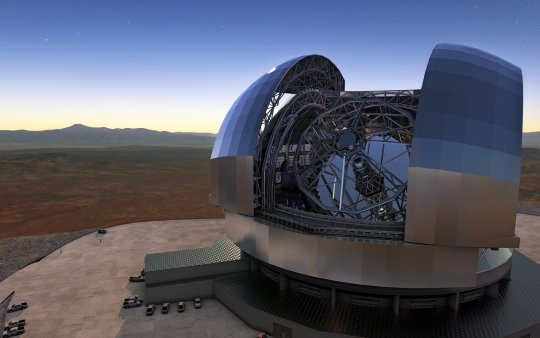
View On WordPress
#European Space Agency#exoplanets#extraterrestrial life#Extremely Large Telescope#James Webb Space Telescope#The Range
1 note
·
View note
Video
youtube
La Via Lattea ripresa in 4k presso il Cerro Armazones (Cile)
MARAVILLA!!!!
“Cielos de CHILE”
0 notes
Text
Need a Project? You can Build a Paper Model of the Extremely Large Telescope
Need a Project? You can Build a Paper Model of the Extremely Large Telescope
The Extremely Large Telescope (ELT) will be the world’s largest optical/near-infrared telescope. It is under construction on top of a mountain named Cerro Armazones in the Atacama Desert of northern Chile. Now you can build your own slightly smaller, incredibly lower cost version of your own ELT – using paper.As the instructions say, all you need is some A4 paper, a paper cutter or scissors, glue…
View On WordPress
0 notes
Link
Caros Leitores; Esta Foto da Semana mostra uma vista, em tom pastel, do Cerro Armazones, no deserto chileno do Atacama. No final da estrad...
0 notes
Text
How Do Telescopes Work?
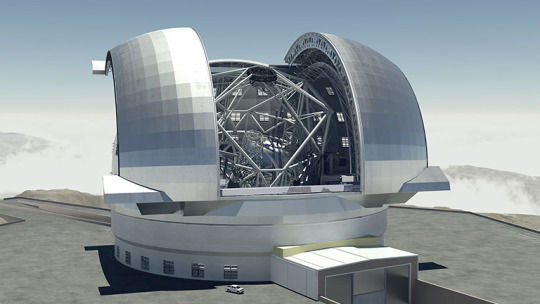
What is a Telescope? Telescopes are instruments used to observe distant objects by gathering and focusing their light. The word telescope was coined in the early 1600s, based on the Greek word for "far sighted" or "to see at a distance." Telescopes work because they use lenses to collect and focus light from distant objects. The basic design of a telescope consists of a long, narrow tube with one or more large lenses at one end, and an eyepiece at the other end. The size of the lens(es) determines how much light is collected—the larger the lens(es), the more light can be collected. How Do Telescopes Work? Telescopes are one of the most important inventions in the history of science. They were invented by Galileo Galilei in 1609, and they allow scientists to look at objects that are too far away to see with the naked eye. Telescopes work by collecting light from distant objects and focusing it into a sharp image. Telescopes can be categorized according to their design or size, but they all work on the same basic principle: they collect light and bring it into focus. Types of Telescopes and What They Do Telescopes are used for a variety of purposes, including astronomy and navigation. Refracting telescopes use lenses to form an image. They are usually more portable than other types of telescope and can be used for a wider range of applications, but they have a smaller aperture size. Reflecting telescopes use mirrors to form an image and typically have a larger aperture size than refracting telescopes. Telescopes are used in many different fields, including astronomy and navigation. Refracting telescopes use lenses to form an image while reflecting telescopes use mirrors to form the image. The refracting telescope is usually more portable than other types of telescope but has a smaller aperture size while the reflecting telescope has a larger aperture size but is less portable.
The Biggest Telescopes on Earth
What is the Biggest Telescope on Earth? The largest telescope is the Extremely Large Telescope, which is located in Chile. It was built by the European Southern Observatory (ESO). The ESO is an international organization of 16 countries that provides research and other scientific services to astronomers. They are responsible for building and operating the world's most advanced ground-based astronomical observatories. The ESO has four main observing sites in Chile: La Silla, Paranal, Chajnantor and La Palma. The largest telescope is the Extremely Large Telescope (ELT), which is located in Chile at Cerro Armazones on Cerro Armazones. It was built by the European Southern Observatory (ESO). The ELT will be a 39 meter-diameter aperture optical/near-infrared telescope with a segmented primary mirror composed of 798 hexagonal segments with a total weight of 1178 tonnes. How Big is the Largest Optical Telescope in the World? The largest optical telescope in the world is the Gran Telescopio Canarias (GTC). It is located on the island of La Palma in Spain. The GTC has a diameter of 10.4 meters and weighs about 220 metric tons. It was built at a cost of about US$200 million and took about five years to assemble. The telescope is operated by a consortium of European countries, led by Spain. The Largest Radio Telescope at Jodrell Bank Observatory Jodrell Bank Observatory is a famous radio telescope in the UK. It is the third largest steerable dish radio telescope in the world. The Jodrell Bank Observatory is situated close to the village of Goostrey, Cheshire, England. The observatory was established in 1945 by Sir Bernard Lovell and it has been managed by The University of Manchester since 1957. The observatory’s most notable feature is its 76-meter (250 ft) diameter radio telescope, which at one time was the third largest steerable dish radio telescope in the world. Read the full article
0 notes
Photo

An incredible view This image was taken at 3060m above sea level (10,000ft), on the mountain peak of Cerro Armazones in Chile. The high number of star trails is testament to the dark, clear site. This is one of the reasons why this mountain top will host the upcoming European Extremely Large Telescope (E-ELT).
The E-ELT, nicknamed the “world's biggest eye on the sky” will have a 39m (128ft) primary mirror and will constitute the largest optical/near-infrared telescope on Earth. Other statistics for the E-ELT are just as staggering: The light collecting area of the entire telescope is 978 square metres. The primary (39m) mirror will be made up of over 800 hexaganal segments, each about 1.4m across and 5cm thick. -CJ Image Credit: ESO/S.Brunier Further Reading: http://www.eso.org/public/images/potw1321a/ http://www.eso.org/public/teles-instr/e-elt.html
#E-Elt#night sky#star trails#chile#cerro armazones#mountain#dark sky#clear#night#photography#long exposure#European Extremely Large Telescope#science#astronomy#the universe#the real universe
16 notes
·
View notes
Text

Preparations are being put in place to resume construction work on ESO’s Extremely Large Telescope (ELT) at Cerro Armazones in Chile, following disruption due to the COVID-19 pandemic, which forced the closure of the site in mid-2020. As work on manufacturing and design elements of the ELT in Europe progressed steadily, the evolution of this complex and ambitious project, set to revolutionise modern astronomy, has been closely monitored over the past year. ESO’s ELT is now expected to deliver the first scientific observations in September 2027, about half a year after an initial “telescope technical first light”.
In the last few weeks, the Italian consortium ACe (Cimolai, Astaldi) in charge of the dome and main structure construction, has started preparations to resume on-site activities on ESO’s ELT in the Chilean Atacama Desert, within the health and safety restrictions established by the country’s authorities. With this important return to work in Chile, it has been possible to assess the first impact the global pandemic has had on the ELT schedule. Most of the project work across Europe continued despite the adverse and changeable pandemic situation since early 2020, but the construction schedule of the telescope has so far suffered a delay estimated to be around a year and a half.
Once completed, ESO’s ELT will be the largest optical telescope in the world, collecting more light than all of the existing 8–10-metre class telescopes on the planet combined. With its 39-metre main mirror and unique five-mirror design, coupled with state-of-the-art technology to correct for atmospheric distortions, it will provide images 15 times sharper than those from the Hubble Space Telescope. ESO’s ELT will be used to push scientific boundaries in fields such as habitable exoplanet discovery, galaxy formation or the study of dark energy and dark matter.
The scientific capabilities of ESO’s ELT will be unaffected by this new construction schedule, and once it begins scientific operations, the ELT will tackle the biggest astronomical challenges of our time and make discoveries which are currently unimaginable.
Want to see it being built in real time? Check the construction progress on our webcam: https://www.eso.org/public/outreach/webcams/#armazones
https://www.eso.org/public/announcements/ann21008/?fbclid=IwAR3wvB2MHMBTRXqCI6Gk8OANJWCT7tQuElUq8OJahC9uw55CVMMPbyhrZ_o
6 notes
·
View notes
Text

El Extremely Large Telescope (ELT), nuestro nuevo telescopio insignia que se está construyendo para responder a las preguntas más importantes sobre nuestro Universo, ha recibido un aumento del 10% en su presupuesto. Este aumento de financiación ahora aprobado por el Consejo de ESO aporta el costo total del proyecto a 1.300 millones de euros y mejorará las capacidades científicas del ELT. El telescopio, ubicado en Cerro Armazones cerca de nuestro Observatorio Paranal en el norte de Chile, comenzará a operar a finales de esta década. #BiggestEyeOnTheSky #ELTprogress
Crédito de la imagen: ESO Astronomy
http://orlo.uk/2VVj5
2 notes
·
View notes